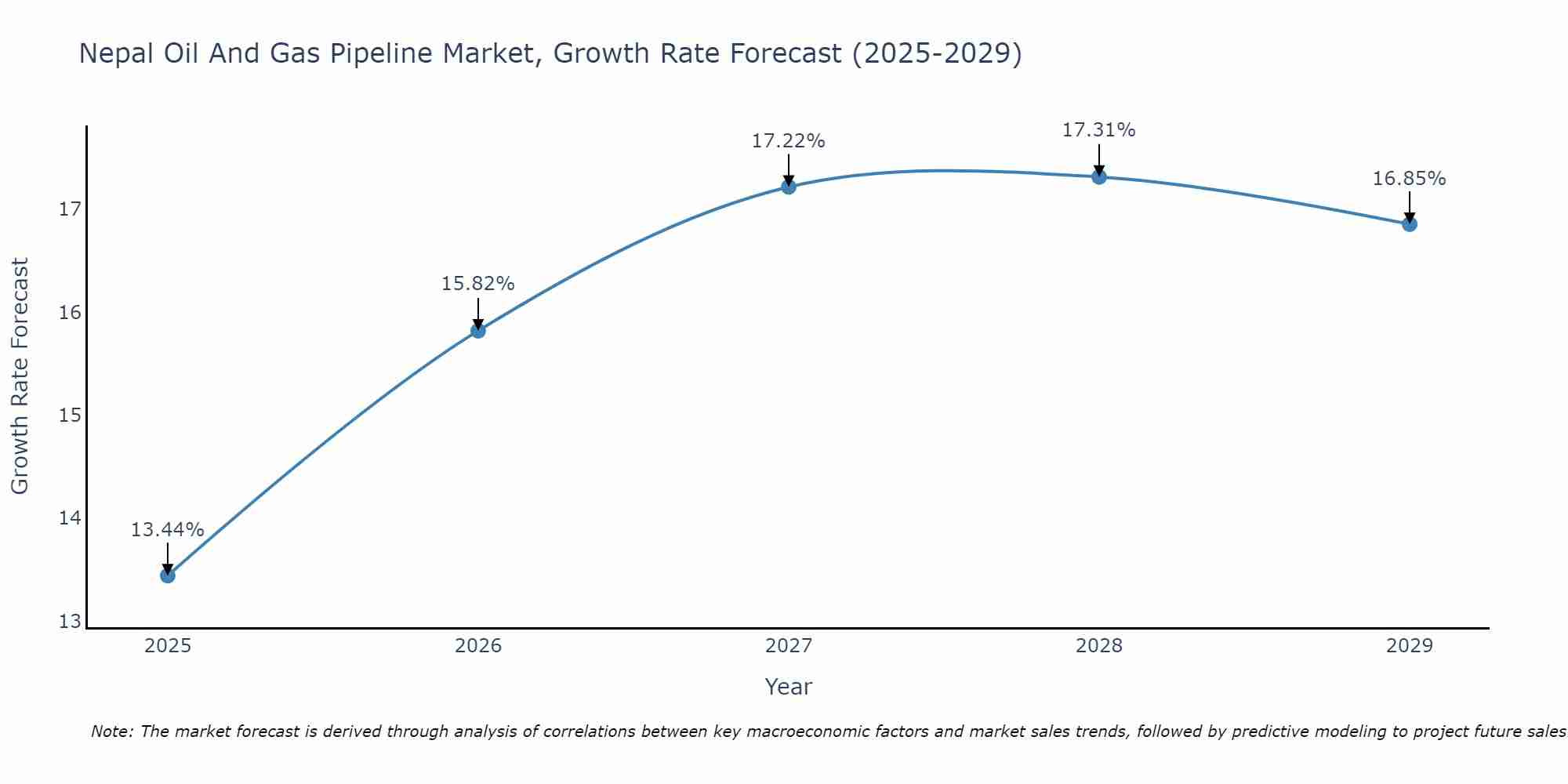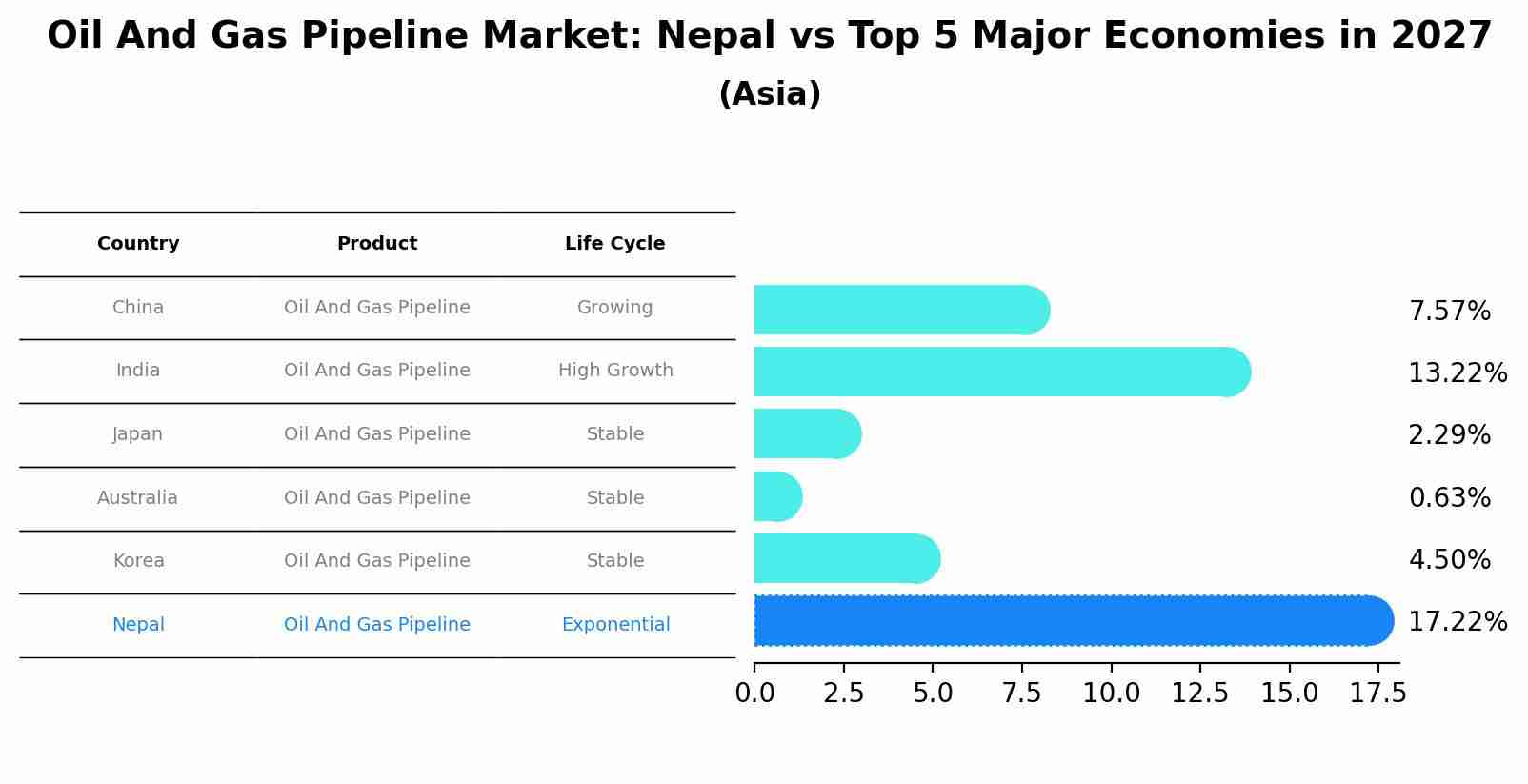Nepal Oil And Gas Pipeline Market (2025-2031) Outlook | Forecast, Value, Size, Analysis, Industry, Share, Trends, Revenue, Growth & Companies
| Product Code: ETC377316 | Publication Date: Aug 2022 | Updated Date: Jul 2025 | Product Type: Market Research Report | |
| Publisher: 6Wresearch | Author: Vasudha | No. of Pages: 75 | No. of Figures: 35 | No. of Tables: 20 |
Nepal Oil And Gas Pipeline Market Size Growth Rate
The Nepal Oil And Gas Pipeline Market is projected to witness mixed growth rate patterns during 2025 to 2029. Growth accelerates to 17.31% in 2028, following an initial rate of 13.44%, before easing to 16.85% at the end of the period.

Oil And Gas Pipeline Market: Nepal vs Top 5 Major Economies in 2027 (Asia)
The Oil And Gas Pipeline market in Nepal is projected to grow at a exponential growth rate of 17.22% by 2027, highlighting the country's increasing focus on advanced technologies within the Asia region, where China holds the dominant position, followed closely by India, Japan, Australia and South Korea, shaping overall regional demand.

Nepal Oil And Gas Pipeline Market Synopsis
The Nepal Oil and Gas Pipeline Market is experiencing significant growth due to the country`s increasing energy demands and efforts to enhance energy security. The market is primarily driven by the need to reduce dependency on imported fuels and the government`s focus on expanding and modernizing the existing pipeline infrastructure. Key players in the market are actively investing in the development of new pipelines and the refurbishment of existing ones to meet the growing demand for oil and gas transportation. Additionally, advancements in pipeline technology and the government`s initiatives to promote the use of natural gas are expected to further boost the market growth in the coming years, providing opportunities for both domestic and international companies looking to capitalize on Nepal`s evolving energy sector.
Nepal Oil And Gas Pipeline Market Trends
In the Nepal Oil and Gas Pipeline market, the current trends primarily revolve around the expansion and modernization of the existing infrastructure to meet the growing energy demands of the country. The focus is on improving the efficiency and reliability of the pipeline network through the adoption of advanced technologies and practices. Additionally, there is a growing emphasis on promoting sustainability and reducing environmental impact by incorporating eco-friendly solutions in pipeline construction and operations. Moreover, the government`s initiatives to attract foreign investments and partnerships for the development of new pipeline projects are also shaping the market dynamics. Overall, the Nepal Oil and Gas Pipeline market is witnessing a shift towards innovation, sustainability, and collaboration to address the evolving energy needs of the country.
Nepal Oil And Gas Pipeline Market Challenges
In the Nepal Oil and Gas Pipeline Market, one of the key challenges is the lack of a well-developed infrastructure for pipeline transportation. The rugged terrain and difficult geographical conditions in Nepal make it challenging to construct and maintain pipelines efficiently. Additionally, the country`s limited financial resources and bureaucratic hurdles further hinder the development of a robust pipeline network. Political instability and regulatory uncertainties also pose significant challenges for companies looking to invest in pipeline projects in Nepal. Moreover, the country`s heavy reliance on imported petroleum products adds pressure to establish a reliable and efficient pipeline system to meet the growing energy demands. Overall, overcoming these challenges will require significant investments, strong government support, and effective regulatory frameworks to drive the growth of the oil and gas pipeline market in Nepal.
Nepal Oil And Gas Pipeline Market Investment Opportunities
Investment opportunities in the Nepal oil and gas pipeline market are promising due to the country`s growing energy demand and the government`s focus on infrastructure development. Key opportunities include investing in the construction and expansion of oil and gas pipelines to enhance the distribution network across the country. Additionally, there is potential for investment in technologies that improve pipeline efficiency, safety, and monitoring systems. With Nepal aiming to reduce its reliance on imported energy sources and promote domestic production, there are opportunities for investors to participate in projects that support the development of the oil and gas sector. Overall, investing in the Nepal oil and gas pipeline market can provide long-term returns and contribute to the country`s energy security and economic growth.
Jordan Agar Market Government Policies
The Nepal Oil and Gas Pipeline Market is heavily regulated by the government through various policies aimed at promoting energy security and efficient infrastructure. The government has implemented the Petroleum Pipeline Policy, which outlines the guidelines for the construction, operation, and maintenance of oil and gas pipelines in the country. Additionally, regulatory bodies such as the Nepal Oil Corporation (NOC) oversee the licensing and monitoring of pipeline projects to ensure compliance with safety and environmental standards. The government also encourages private sector participation in pipeline development through public-private partnerships to enhance efficiency and investment in the sector. Overall, government policies in Nepal focus on fostering a competitive and sustainable oil and gas pipeline market while ensuring energy security and environmental protection.
Nepal Oil And Gas Pipeline Market Future Outlook
The future outlook for the Nepal Oil and Gas Pipeline Market appears promising, driven by the country`s growing energy demands and increasing investments in infrastructure development. The government`s focus on expanding the pipeline network to enhance energy security and efficiency is expected to boost market growth. Additionally, the shift towards cleaner energy sources and a growing emphasis on renewable energy projects could create opportunities for pipeline development in the future. However, challenges such as regulatory hurdles, funding constraints, and geopolitical factors may impact the pace of growth in the market. Overall, with supportive government initiatives and rising energy needs, the Nepal Oil and Gas Pipeline Market is likely to witness steady expansion in the coming years.
Key Highlights of the Report:
- Nepal Oil And Gas Pipeline Market Outlook
- Market Size of Nepal Oil And Gas Pipeline Market, 2024
- Forecast of Nepal Oil And Gas Pipeline Market, 2031
- Historical Data and Forecast of Nepal Oil And Gas Pipeline Revenues & Volume for the Period 2021 - 2031
- Nepal Oil And Gas Pipeline Market Trend Evolution
- Nepal Oil And Gas Pipeline Market Drivers and Challenges
- Nepal Oil And Gas Pipeline Price Trends
- Nepal Oil And Gas Pipeline Porter's Five Forces
- Nepal Oil And Gas Pipeline Industry Life Cycle
- Historical Data and Forecast of Nepal Oil And Gas Pipeline Market Revenues & Volume By Location of Deployment for the Period 2021 - 2031
- Historical Data and Forecast of Nepal Oil And Gas Pipeline Market Revenues & Volume By Onshore for the Period 2021 - 2031
- Historical Data and Forecast of Nepal Oil And Gas Pipeline Market Revenues & Volume By Offshore for the Period 2021 - 2031
- Historical Data and Forecast of Nepal Oil And Gas Pipeline Market Revenues & Volume By Type for the Period 2021 - 2031
- Historical Data and Forecast of Nepal Oil And Gas Pipeline Market Revenues & Volume By Crude Oil Pipeline for the Period 2021 - 2031
- Historical Data and Forecast of Nepal Oil And Gas Pipeline Market Revenues & Volume By Gas Pipeline for the Period 2021 - 2031
- Nepal Oil And Gas Pipeline Import Export Trade Statistics
- Market Opportunity Assessment By Location of Deployment
- Market Opportunity Assessment By Type
- Nepal Oil And Gas Pipeline Top Companies Market Share
- Nepal Oil And Gas Pipeline Competitive Benchmarking By Technical and Operational Parameters
- Nepal Oil And Gas Pipeline Company Profiles
- Nepal Oil And Gas Pipeline Key Strategic Recommendations
Frequently Asked Questions About the Market Study (FAQs):
- Single User License$ 1,995
- Department License$ 2,400
- Site License$ 3,120
- Global License$ 3,795
Search
Related Reports
- ASEAN Bearings Market (2025-2031) | Strategy, Consumer Insights, Analysis, Investment Trends, Opportunities, Growth, Size, Share, Industry, Revenue, Segments, Value, Segmentation, Supply, Forecast, Restraints, Outlook, Competition, Drivers, Trends, Demand, Pricing Analysis, Competitive, Strategic Insights, Companies, Challenges
- Europe Flooring Market (2025-2031) | Outlook, Share, Industry, Trends, Forecast, Companies, Revenue, Size, Analysis, Growth & Value
- Saudi Arabia Manlift Market (2025-2031) | Outlook, Size, Growth, Trends, Companies, Industry, Revenue, Value, Share, Forecast & Analysis
- Uganda Excavator, Crane, and Wheel Loaders Market (2025-2031) | Strategy, Consumer Insights, Analysis, Investment Trends, Opportunities, Growth, Size, Share, Industry, Revenue, Segments, Value, Segmentation, Supply, Forecast, Restraints, Outlook, Competition, Drivers, Trends, Demand, Pricing Analysis, Competitive, Strategic Insights, Companies, Challenges
- Rwanda Excavator, Crane, and Wheel Loaders Market (2025-2031) | Strategy, Consumer Insights, Analysis, Investment Trends, Opportunities, Growth, Size, Share, Industry, Revenue, Segments, Value, Segmentation, Supply, Forecast, Restraints, Outlook, Competition, Drivers, Trends, Demand, Pricing Analysis, Competitive, Strategic Insights, Companies, Challenges
- Kenya Excavator, Crane, and Wheel Loaders Market (2025-2031) | Strategy, Consumer Insights, Analysis, Investment Trends, Opportunities, Growth, Size, Share, Industry, Revenue, Segments, Value, Segmentation, Supply, Forecast, Restraints, Outlook, Competition, Drivers, Trends, Demand, Pricing Analysis, Competitive, Strategic Insights, Companies, Challenges
- Angola Excavator, Crane, and Wheel Loaders Market (2025-2031) | Strategy, Consumer Insights, Analysis, Investment Trends, Opportunities, Growth, Size, Share, Industry, Revenue, Segments, Value, Segmentation, Supply, Forecast, Restraints, Outlook, Competition, Drivers, Trends, Demand, Pricing Analysis, Competitive, Strategic Insights, Companies, Challenges
- Israel Intelligent Transport System Market (2025-2031) | Strategy, Consumer Insights, Analysis, Investment Trends, Opportunities, Growth, Size, Share, Industry, Revenue, Segments, Value, Segmentation, Supply, Forecast, Restraints, Outlook, Competition, Drivers, Trends, Demand, Pricing Analysis, Competitive, Strategic Insights, Companies, Challenges
- Uganda Precast and Aggregate Market (2025-2031) | Strategy, Consumer Insights, Analysis, Investment Trends, Opportunities, Growth, Size, Share, Industry, Revenue, Segments, Value, Segmentation, Supply, Forecast, Restraints, Outlook, Competition, Drivers, Trends, Demand, Pricing Analysis, Competitive, Strategic Insights, Companies, Challenges
- Australia IT Asset Disposal Market (2025-2031) | Strategy, Consumer Insights, Analysis, Investment Trends, Opportunities, Growth, Size, Share, Industry, Revenue, Segments, Value, Segmentation, Supply, Forecast, Restraints, Outlook, Competition, Drivers, Trends, Demand, Pricing Analysis, Competitive, Strategic Insights, Companies, Challenges
Industry Events and Analyst Meet
Our Clients
Whitepaper
- Middle East & Africa Commercial Security Market Click here to view more.
- Middle East & Africa Fire Safety Systems & Equipment Market Click here to view more.
- GCC Drone Market Click here to view more.
- Middle East Lighting Fixture Market Click here to view more.
- GCC Physical & Perimeter Security Market Click here to view more.
6WResearch In News
- Doha a strategic location for EV manufacturing hub: IPA Qatar
- Demand for luxury TVs surging in the GCC, says Samsung
- Empowering Growth: The Thriving Journey of Bangladesh’s Cable Industry
- Demand for luxury TVs surging in the GCC, says Samsung
- Video call with a traditional healer? Once unthinkable, it’s now common in South Africa
- Intelligent Buildings To Smooth GCC’s Path To Net Zero













